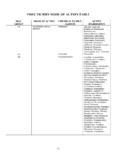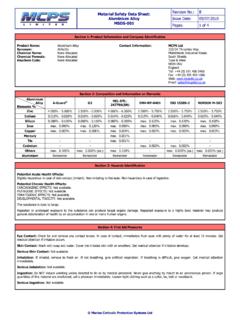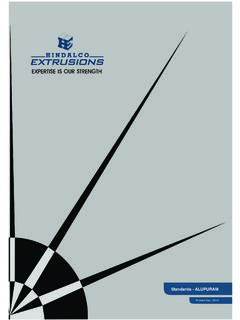Transcription of Children's Health and the Environment - WHO
1 TRAINING FOR THE Health SECTOR. [Date Place Event . Event Sponsor . Sponsor Organizer]. PESTICIDES. Children's Health and the Environment WHO Training Package for the Health Sector World Health Organization July 2008 version 1. <<NOTE TO USER: Please add details of the date, time, place and sponsorship of the meeting for which you are using this presentation in the space indicated.>>. <<NOTE TO USER: This is a large set of slides from which the presenter should select the most relevant ones to use in a specific presentation. These slides cover many facets of the problem. Present only those slides that apply most directly to the local situation in the region.>>. Pesticides LEARNING OBJECTIVES. Learn about pesticides what they are and what are the risks they may pose? Identify the scenarios where and when are children exposed? Recognize signs, symptoms and diseases that may be related to pesticide exposure in children Know how to prevent and treat Children's pesticide exposure 2.
2 <<READ SLIDE.>>. Pesticides OVERVIEW. What are pesticides? Origin, environmental transport and fate of pesticides Routes and circumstances of exposure Exposure levels Toxicokinetics and toxicodynamics Target organs and systems Diagnosis and treatment of poisoning Prevention of pesticide exposure and poisoning 3. <<READ SLIDE.>>. Pesticides PESTICIDES RISKS AND BENEFITS. BENEFITS RISKS. Crop protection Toxic to humans Food preservation Impact on Environment Material preservation and ecosystems Disease control 4. Pesticides have numerous beneficial effects. These include crop protection, preservation of food and materials and prevention of vector-borne diseases. For example pesticides may be used in the prevention of malaria, which kills up to 1 million children per year, and for preventing other vector-borne diseases such as dengue, leishmaniasis and Japanese encephalitis.
3 Pesticides are toxic by design they are BIOCIDES, designed to kill, reduce or repel insects, weeds, rodents, fungi or other organisms that can threaten public Health and the economy. Their mode of action is by targeting systems or enzymes in the pests which may be identical or very similar to systems or enzymes in human beings and therefore, they pose risks to human Health and the Environment . Pesticides are ubiquitous in the Environment and most are synthetic. There is growing concern about Children's exposure to pesticides and their special susceptibility. Children are not little adults, and may have higher exposures and greater vulnerability at both high and low levels of exposure. Ref: National Resource Council. Pesticides in the diets of infants and children. National Academy Press, Washington, DC, 1993. Pesticides USE OF PESTICIDES.
4 First use of synthetic pesticides: 1940. Consumption increasing worldwide million tons of active ingredients used in 2001. 25% of the world production used in developing where 99% of deaths due to pesticides occur! 5. <<READ SLIDE.>>. a) First use of synthetic pesticides: 1940. b) Consumption increased substantially over time, for example, in the USA, the use of pesticides doubled from 1960 to 1980, but total use has since remained stable or fallen. Most pesticides are used in agriculture, but in 1999 about 74% of households in USA were reported to use at least one pesticide in the home. c) Use has risen in developing countries and the fastest growing markets in Africa, Asia, South and Central America, Eastern Mediterranean. There is a high pesticide use on crops grown for export (Dr. N. Besbelli, WHO, personal communication).
5 D) Although developing countries use only 25% of the pesticides produced worldwide, they experience 99% of the deaths. This is because use of pesticides tends to be more intense and unsafe, and regulatory, Health and education systems are weaker in developing countries. Refs: American Academy of Pediatrics Committee on Environmental Health . Pesticides. In: Etzel RA ed. Pediatric Environmental Health . 2nd ed. Elk Grove Village, American Academy of Pediatrics, 2003. Jeyaratnam J. Acute pesticide poisoning: a major global Health problem. World Health Stat Quarterly, 1990. UNEP United Nations Children s Fund and WHO. Children in the new millennium: environmental impact on Health . UNEP, UNICEF, WHO, 2002. US EPA Pesticides industry sales and usage: 2000 & 2001 market estimates: ( ). Vaagt G. New code of conduct on pesticide adopted.
6 FAO Newsroom ( ). Pesticides USE OF PESTICIDES. Global Pesticide Use 2001 (%). herbicide insecticide fungicide other 6. The pie chart shows the global use of pesticides and the different types. Insecticides are mostly used in developing countries and fungicides/herbicides in developed countries. <<READ SLIDE.>>. Refs: American Academy of Pediatrics Committee on Environmental Health . Pesticides. In: Etzel RA ed. Pediatric Environmental Health . 2nd ed. Elk Grove Village, American Academy of Pediatrics, 2003. Jeyaratnam. Acute pesticide poisoning: a major global Health problem. World Health Stat Quarterly, 1990. UNEP United Nations Children s Fund and WHO. Children in the new millennium: environmental impact on Health . UNEP, UNICEF, WHO, 2002. US EPA Pesticides industry sales and usage: 2000 & 2001 market estimates: ( ). Vaagt. New code of conduct on pesticide adopted.
7 FAO Newsroom ( ). Pesticides USE OF PESTICIDES TYPES OF PRODUCT. Pesticides used in different settings: - Agricultural - Veterinary - Domestic - Institutional Formulations: liquid, gel, paste, chalk, powder, granules, pellets, Concentrations: from 2% to 80% of active ingredient Containers: glass, plastic or metal flasks, bottles, drums, traps, plastic bags or paper 7. Pesticides are used in different settings. <<READ SLIDE.>>. It is important to consider the presentation, concentration and formulation of the products, as the toxic effects depend on the physical state of the product and also on the characteristics of the solvent or other substances contained in the formulation. "Chalk" pesticide has been sold illegally in the USA, it may contain pyrethroids. (See US EPA website.). The rate of absorption depends upon the presentation of the product: volatile pesticides and fine powders are more easily inhaled than dense products and coarse granulated materials.
8 Concentrated solutions are much more dangerous than diluted ones; solid baits may be colourful, attractive and sweet, and may be easily ingested by toddlers. In some cases, if the concentration of the active compound is less than 2% (as is generally the case for pesticides for household use), the toxicity in cases of human exposure may be due to the solvent ( kerosene or paraffin) and not to the active ingredient. Refs: IPCS. The WHO Recommended Classification of pesticides by hazard, Guidelines to Classification 2000 2002 ( ). Tomlin C. The pesticide manual, 11th ed. British Crop Protection Council Publications, 1997. "Chalk" pesticides information at Pesticides PESTICIDES CLASSIFICATION BY USE. Chemicals designed to kill, reduce or repel pests Rats, mice, Insects Weeds Moulds moles Insecticides Herbicides Fungicides Rodenticides Insect repellents Wood preservatives Fumigants 8.
9 There is a large variety of pesticides designed to kill specific pests those most widely used are listed below. Insecticides (for killing insects) such as organochlorines, organophosphates and carbamates. This category also includes insect repellents such as diethyltoluamide (DEET). and citronella (of natural origin). Herbicides or weedkillers ( paraquat, glyphosate and propanil). Fungicides (to kill mould or fungi): when applied to wood, they are called wood preservatives. Rodenticides (to kill mice, rats, moles and other rodents). Fumigants are pesticides that exist as a gas or a vapour at room temperature and may be used as insecticides, fungicides or rodenticides, especially in closed storage places as they kill every living organism. They are extremely toxic, due to their physical properties, rapid environmental dissemination and human or animal absorption (examples include cyanide, aluminium phosphate and methyl bromide).
10 Other pesticides include algaecides (to kill algae), miticides (to kill moths) and acaricides (to kill ticks). Pesticides PESTICIDES CLASSIFICATION BY USE. AND CHEMICAL STRUCTURE. Different chemicals used for different purposes INSECTICIDES FUNGICIDES RODENTICIDES. Pyrethroids Thiocarbamates Warfarines Indanodiones Organophosphorus Dithiocarbamates Carbamates Cupric salts Organochlorine Tiabendazoles FUMIGANTS. Manganese compounds Triazoles Aluminium and zinc Dicarboximides phosphide Dinitrophenoles Methyl bromide HERBICIDES. Organotin compounds Ethylene dibromide Bipyridyls Miscellaneous Chlorophenoxy Glyphosate INSECT REPELLENTS. Acetanilides Triazines Diethyltoluamide 9. There are many groups of chemicals used as pesticides. There are hundreds of different active principles or main ingredients of pesticide groups ( approximately 300 in Uruguay and 900 in the USA).













